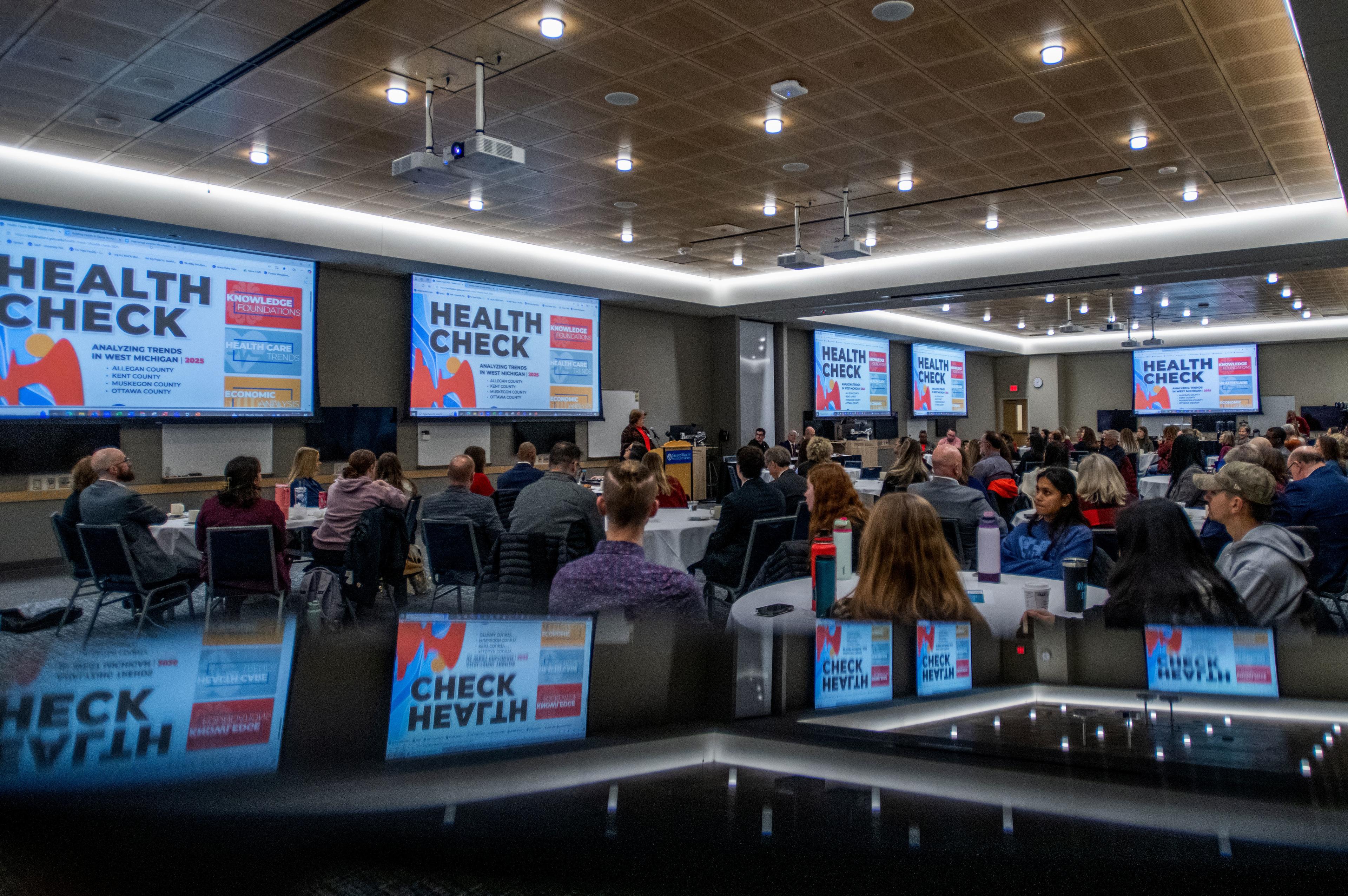West Michigan Sees Rising Levels of Health Care Employment, More Citizens Covered by Insurance and Fewer Hospital Admissions, According to New Data
Jake Newby
| 5 min read

Health care leaders in West Michigan are optimistic about the region’s future based on statistics discussed at this year’s Health Economic Forecast at Grand Valley State University (GVSU).
An aging population points to an increasing demand for health care, but new research suggests West Michigan’s health care providers and universities are ready to meet that demand, as evidenced by increasing health care employment, earnings and enrollment in high return degrees related to health care.
The area has also seen a dip in hospitalizations, fewer instances of delayed care and more people covered by health insurance.
The future of health care employment in West Michigan looks bright
Between 2005 and 2022, health care employment in West Michigan has outpaced state and national levels, according to Cody Kirby, Ph.D., visiting faculty in the GVSU Department of Economics. Kirby stated during his presentation that average earnings for health care workers in West Michigan since 2011 exceeds both the state and national levels in that time.
“This is going to attract new talent, this is going to retain existing talent,” said Kirby, who compiled statistics based on residents living in the West Michigan counties of Kent, Ottawa, Muskegon and Allegan (KOMA).

In terms of health care education, enrollment in physician assistant enrollment is up by 6% in the last year and nursing enrollment is up by 6.4% in that same time.
“If we look at med school in general, it too, is up,” Kirby said. “I think the future looks promising.”
Hospital admissions and health care spending drops
Hospital admissions are typically low in Grand Rapids, even during the COVID-19 pandemic, when health care facilities had every incentive to keep people out of the hospital.
During his presentation, Daniel Montanera, Ph.D., assistant professor in the GVSU Department of Economics said hospital admission rate hit an all-time low since data was first tracked in 2005, with 80 admissions per 1,000 population.
Montanera said utilization– which is the use of health care spending – is down across an inpatient and outpatient basis. He noted that 2021’s spike in emergency department (ED) visits in Grand Rapids dipped from nearly 500 admissions per 1,000 in 2021 to 400 admissions per 1,000. He said an increase in mental-health related ED visits during the heart of the pandemic may have contributed to the spike.

Reason for optimism: Detroit narrows the gap in health care utilization per member across six major medical conditions
Historically, there has been a regional gap in utilization between Detroit and Grand Rapids, but Detroit narrowed the gap in 2023, according to member data collected by Blue Cross Blue Shield of Michigan (BCBSM), Blue Care Network (BCN) and Priority Health.
During his presentation, Montanera compared inpatient care visits between Detroit and KOMA residents due to these six major medical conditions:
- Asthma
- Coronary artery disease
- Depression
- Diabetes
- Hyperlipidemia
- Low back pain
Fewer members in Detroit are requiring inpatient services for these services, particularly for coronary artery disease, depression and low back pain. Montanera noted a similarly narrowing gap in Detroit across annual ED visits and annual prescription fills per members.
“This matters in terms of comparative advantage for firms setting up businesses,” Montanera said. “One of the things they consider is how expensive health care insurance is going to be, and that’s tied to health care utilization. Good news for Detroit.”
Health care leaders did note in this year’s Health Economic Forecast executive summary they continue to find differences in racial disparities between the two regions, but less stark than research compiled last year. The key income disparities in disease prevalence in KOMA uncovered in last year’s report remain and tend to be greater in magnitude than Detroit, according to the summary.

Analyzing cost and care in West Michigan
Since 2011 – which Kirby measured because it marked the end of the Great Recession – fewer people are delaying care for reasons related to cost.
“This isn’t surprising because since the Great Recession the average inflation rate in West Michigan is 2%,” Kirby said. “That’s perfectly consistent with the Federal Reserve’s target for what a healthy economy should look like.
However, since the COVID-19 pandemic, that inflation rate has doubled.
“Our households are strapped for cash,” Kirby noted. “Therefore, more people are likely to delay care than they were maybe five years ago.
Kirby found some seemingly contradictory stats among non-white residents who reported having had more annual checkups and more access to health insurance, while also reporting delayed care related to cost.
“The cost of care is not necessarily the same as cost of a checkup,” Kirby explained. “But what about elective procedures that are outside the scope of insurance? It’s possible these citizens would like these elective procedures, but can’t afford them, and therefore have to delay care related to cost.”
Kirby did note that the number of people covered by health insurance in the last 14 years has increased, even holding steady through the pandemic.
“That’s a good thing,” he said. “More of our citizens are covered.”
Mental health continues to be a concern
West Michigan is experiencing a “mental health problem,” according to Kirby, who noted a rise in depression since the start of the COVID-19 pandemic, which he said could be partly contributed to a rise in alcohol consumption and binge drinking.
Non-white residents and men continue to be less likely to see help, making them less likely to be clinically diagnosed.
Kirby added that alcohol consumption is significantly up among KOMA’s non-white residents and men and has also risen by 13% among females in the region since 2011.
The 2025 West Michigan Health Economic Forecast, was held on Friday, Feb. 7 at GVSU. Click here to view findings from the annual Health Check report, which were made possible by support from BCBSM, BCN and Priority Health.
Photo credit: Kendra Stanley-Mills/GVSU University Communications





